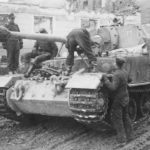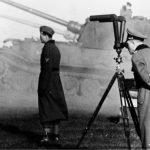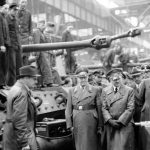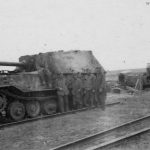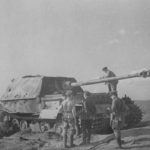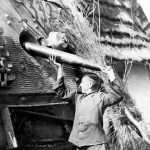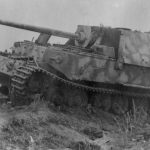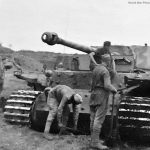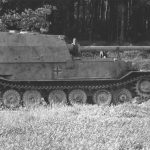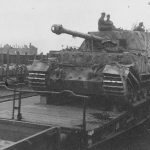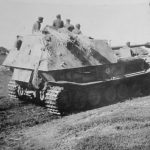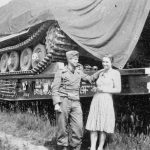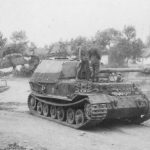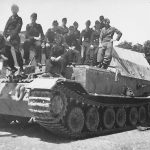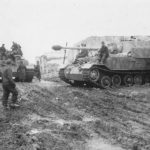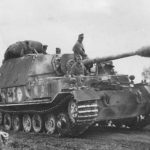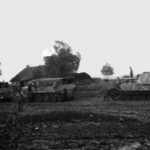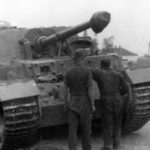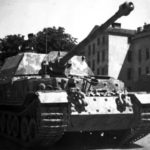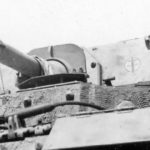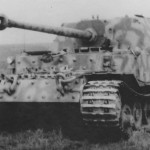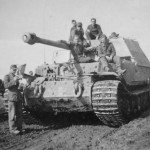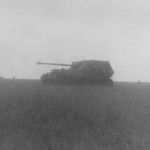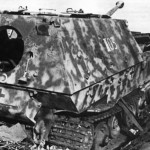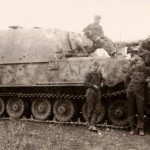Elefant of the PzJgAbt 653 Eastern Front 1944
Gen. Guderian is watching the Ferdinand crews training on the gunnery range. Spring 1943
Hitler and Albert Speer visits the Nibelungenwerke production line. 4 April 1943
Ferdinand Kursk 1943, Operation Citadel
Captured Ferdinand Kursk 2
Tank Destroyer Ferdinand 653 Abt
Elefant 102 of the Kampfgruppe Ulbricht, Italy 1944
Loading ammunition into Elefant 332 Ukraine 1944
Elefants Nibelungenwerke 1944
Ferdinand 723, commander Ofw Busch, Kursk 1943
Ferdinand 653 Abt Kursk
Elefant coated with Zimmerit antimagnetic mine paste
Ferdinand rail transport
Ferdinand 312 Unternehmen Zitadelle 1943
Elefant on railway flatcar
Elefant St. Polten July 1944
Elefant of the sPzJgAbt 653
Elefant 1944
Captured Ferdinand Kursk
Elefants Eastern Front 1944
Ferdinand in field 1943
Panzerjäger Ferdinand Ostfront
Destroyed Elefant 112 Anzio of 1/schwere Panzerjäger-Abteilung 653
Panzerjager Tiger (P) Ferdinand, Eastern Front
Ferdinand 232 from schweres Panzerjäger-Regiment 656
Ferdinand being towed
Ferdinand 150100 in production hall, May 1943
German soldier and Ferdinand
Ferdinand 621 of the schweres Panzerjäger-Regiment 656 and Kubelwagens – Eastern Front
Ferdinand 634 from schweres Panzerjäger-Regiment 656
Elefant 344 Eastern Front
Ferdinand 621 from schwere Panzerjager Abteilung 654
Elefant with “Nibelungen Sword” of Schwere Panzerjäger-Abteilung 653, 1944
Heavy tank destroyer Ferdinand August 1943
Elefant 111 Italy
Ferdinand 513 from schwere Panzerjager Abteilung 654
Heavy tank destroyer Elefant with Zimmerit
Elefant with Zimmerit of the Schwere Panzerjäger-Abteilung 653 – transport to Italy
German Ferdinand tank destroyer stuck in mud
Ferdinand 501 of the schwere Panzerjäger-Abteilung 654 – frontal view
Ferdinand and its crew
Panzerjager Tiger (P) Ferdinand Ukraine 1943
Heavy tank destroyer Ferdinand 150011 trials
Captured Ferdinand 624 of the schweres Panzerjäger-Regiment 656, 1943
Ferdinand 121 Ferdinand 624 of the schweres Panzerjäger-Regiment 656, Eastern Front 1943
Ferdinand 531 of schwere Panzerjager Abteilung 654 Eastern Front
Camouflaged Panzerjäger Tiger (P) Ferdinand
Elefant of 653rd Heavy Panzerjäger Battalion, HQ Company, 1944
Tank destroyer was commanded by Lt Hans-Joachim Wilde
Ferdinand of schwere Panzerjäger-Abteilung 653 October 1943
Elefant from schwere Panzerjäger-Abteilung 653
Ferdinand 534 from schweres Panzerjäger-Regiment 656 – Eastern Front
Ferdinand Panzerjager number 214 Sdkfz 184
Catured Ferdinand number 501, Eastern Front after Operation Citadel 1943
Panzerjager Tiger (P) Elefant of the Panzer Jg Abt. 653
Panzerjager Tiger (P) Elefant Sd.Kfz.184 Ferdinand
Heavy Tank Destroyer Ferdinand
Crew members pose outside of their Elefant tank destroyer. 3/653 Schwere Panzerjäger-Abteilung 653, Poland 1944.
Tank destroyer Ferdinand-Elefant 8,8 cm Pak 43/2 Sfl L/71 Sd Kfz 184
Elefant Panzerjager Sdkfz 184
Ferdinand – Elefant 8,8 cm Pak 43/2 Sd Kfz 184 1944
Ferdinand number 133 of the 1/653 Schwere Panzerjäger-Abteilung, August 1943 eastern front. Commander: Fw. Heinz Rempel.
Ferdinand number 513 of the schwere Panzerjäger-Abteilung 654 – 1943
Crew members pose outside of their Ferdinand tank destroyer, Eastern Front
Ferdinand Elefant Tank Destroyer rail transport
Elefant with zimmerit (non-magnetic coating), Panzerjager Abteilung 653 Italy
Elefant Panzerjager Abteilung 653 eastern front
Elefant Ferdinand Schw.Pz.Jg.Abt. 653
Ferdinand Elefant Panzerjager Abteilung 653
Jagdpanzer Ferdinand Elefant Sd. Kfz 184
Ferdinand Elefant heavy tank destroyer
Heavy tank destroyer Ferdinand
Heavy tank destroyer Ferdinand eastern front
Jagdpanzer Ferdinand Elefant Sd. Kfz 184 2
Heavy tank destroyer Elephant of the 1/653 Schwere Panzerjäger-Abteilung 653, knocked out at Anzio Italy May 1944.
Jagdpanzer Elefant Malo Archangelsk Russia
Ferdinand Tank Destroyer code II03, Eastern Front Operation Citadel 1943
Elefant of the Schwere Panzerjager Abteilung 653
Heavy Tank Destroyer Ferdinand, Eastern Front Operation Citadel 1943
Elefant of the Schwere Panzerjager Abteilung 653, Italy 1944
Elefant Ferdinand Tank destroyers
Elefant of the Schwere Panzerjager Abteilung 653 3
Elefant number 114 of the 1/653 Schwere Panzerjäger-Abteilung, Italy March 1944
Elefant-Ferdinand Tank Destroyer II03
Jagdpanzer Tiger (P) Ferdinand Schwere Panzerjager Abteilung 653 2
Elefant Ferdinand are loaded aboard railcar for transport to the front, 1943
Elefant Schwere Panzerjager Abteilung 653 In Nikopol
Ferdinand of the Schwere Panzerjager Abteilung 653 In Nikopol
Elefant of the Schwere Panzerjager Abteilung 653 4
Tiger (P) Elephant 8,8cm Pak Tank Destroyer Sdkfz184
Elefant number 131 of the 1/653 Schwere Panzerjäger-Abteilung, February 1944 Italy.
Ferdinand Tank Destroyer, coded II03
Panzerjager Tiger (P) Elefant
Ferdinand Sd Kfz 184
Ferdinand Tank Destroyer code “501” of the 1/654 Schwere Panzerjäger Abteilung
Ferdinand number 323 of the schwere Panzerjäger-Abteilung 653 – Eastern Front 1943
Ferdinand Number 623 of the schwere Panzerjäger-Abteilung 654
Ferdinand Sdkfz 184
Ferdinand Tank Destroyer number 113, Ponyri Eastern Front 1943
Elefant (Ferdinand) was german heavy tank destroyer. The official German designation was Panzerjäger Tiger (P) or Sd.Kfz. 184.
Ferdinand was designed on the basis of the chassis of the Tiger (P) prototype tank which was not taken for production and Ferdinand Porsche’s construction known also as VK 4501(P) (the P letter stood for Porsche’s construction). The Ferdinand production was, on one hand, the way of making use of chassis being produced and, on the other hand, an Adolf Hitler’s consolation prize for professor Porsche. Ferdinand was armed in a perfect gun 8,8 cm Pak 43/2 L/71, mounted in an armored superstructure located in the back of the vehicle. However, despite those advantages baptism of fire of Ferdinand in the Battle of Kursk (Operation “Citadel”, German: Unternehmen Zitadelle) was a defeat. Hurriedly produced and incorporated to the service tank destroyers had numerous mechanical defects of suspension and drive. Moreover, that vehicle was too big and too heavy and it did not have a machine gun to self-defense against enemy’s infantry. Ferdinands which survived Kursk, were withdrawn to be modernized. During modernization a machine gun, zimmerit and additional armour were added. 48 vehicles were modernized and their names were changed into Elefant.
It was too complicated and faulty, however, it was an enemy impossible to be defeated on long distances, it could destroy almost every tank of the enemy. Until now there have been two Ferdinands destroyers: in Tank Museum in Kubinka and in US Army Ordnance Museum.
Total production: 90.
Technical specifications
crew | 6 |
lenght | 8140 mm |
width | 3380 mm |
height | 2715 mm |
combat weight | 65000 kg |
ground pressure | 1,23 kg/cm2 |
armor | hull: 100+100 mm front; 80 mm sides and rear, top: 30 mm, bottom 20 mm (+30 mm Elefant) superstructure: 200 mm front, sides : 85 mm, rear: 85 mm, top: 30 mm |
engine: | Maybach HL 120 TRM, 300 hp at 3000 rpm. 12 cylinder, water-cooled, gasoline 11867 cm3. |
electric engine: | Siemens D 1495a, 2×230 kW |
fuel | 1080 l |
fuel consumption (road / off road) per 100 km | 720l / 1200l |
tracks | Kgs 62/600/130 or Kgs 64/640/130 |
number of links per track | 109 |
track contact | 4175 mm |
track base | 2310 mm |
max speed | 20 km/h (12 km/h off-road) |
range | 150 km (90 km off-road) |
grade | 22° |
trench crossing | 2640 mm |
vertical obstacle | 780 mm |
fording | 1000 mm |
ground clearance | 485 mm |
ammunition | 55 (later) rounds |
secondary armament | 1 x MG34 (600 rounds) |
chassis numbers | 150010 – 150100 |
manufacturer | Nibelungenwerke |
Bibliography
- Panzer Tracts No.9 Jagdpanzer Jagdpanzer 38 to Jagdtiger – Thomas L. Jentz, Hilary Louis Doyle
- Tadeusz Melleman: Ferdinand Elefant vol.1 and 2 – AJ-Press GunPower 22 & 23 (Polish/English)
- Janusz Lewoch: Ferdinand Elefant – Wydawnictwo Militaria 187 (Polish/English)
- Thomas Anderson: Ferdinand and Elefant Tank Destroyer, Osprey General Military
- Walter J. Spielberger: Panzerjager Tiger (P) Elefant – Armour in Profile Number 20
- Thomas L.Jentz: Elefant Panzerjager Tiger (P) – Museum Ordnance Special Number 4
- Wolfgang Schneider: Elefant, Jagdtiger, Sturmtiger – Rarities of the Tiger Family
- David Doyle: Ferdinand/Elefant Detail in Action, Squadron/Signal 79001
- Karlheinz Münch, Bo H. Friesen: Combat History of Schwere Panzerjäger Abteilung 653, Formerly the Sturmgeschütz Abteilung 197, 1940-1943
